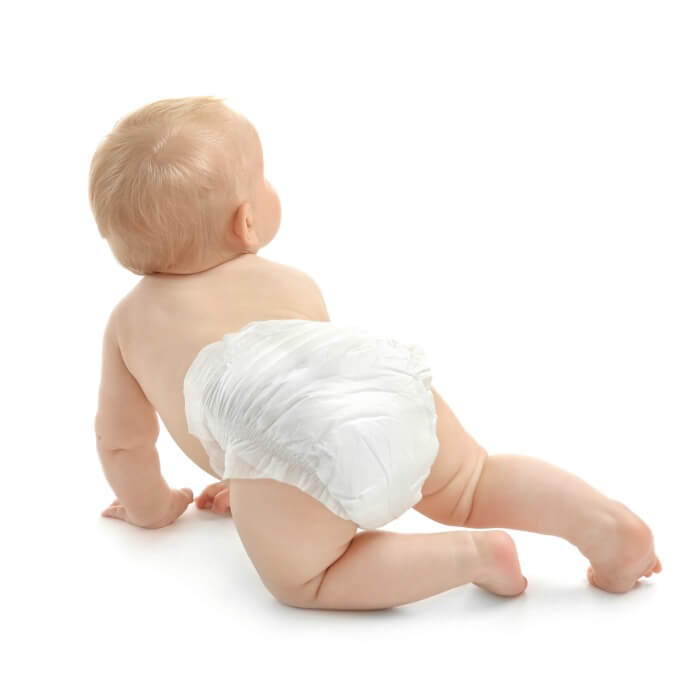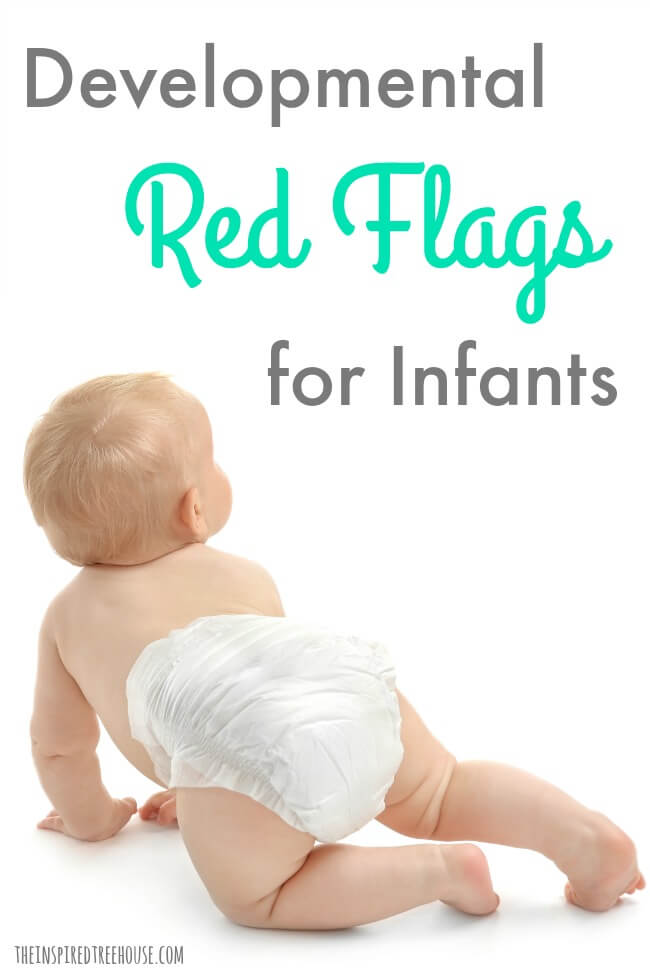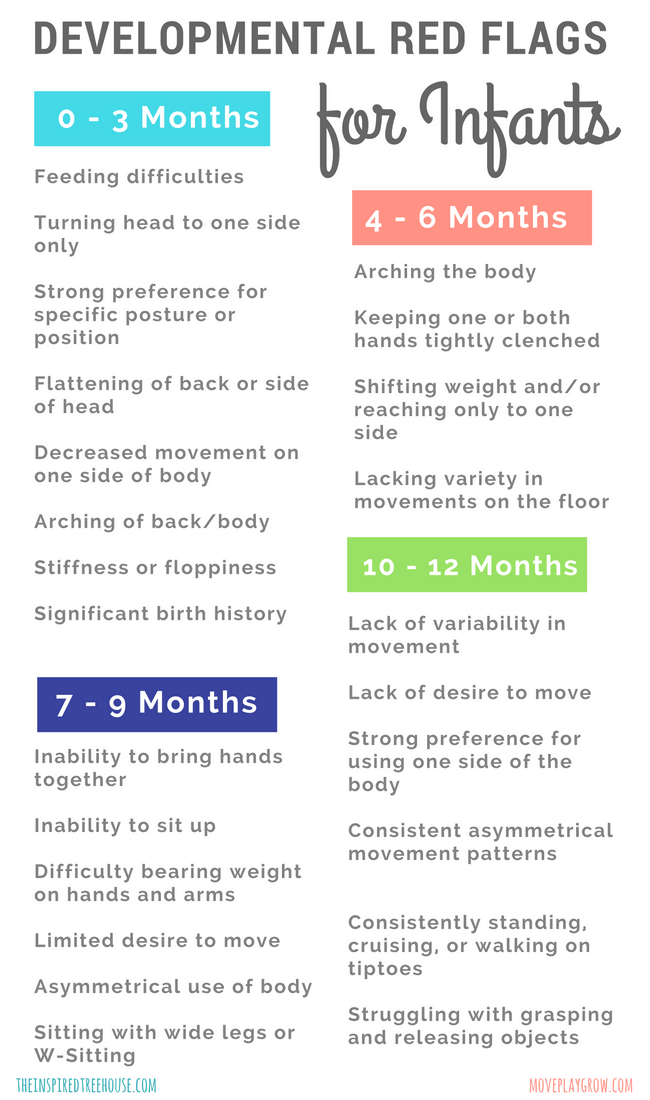Learn about some common developmental red flags for infants that we use to identify developmental delays and other problems.
If there’s one thing we’re sure of (as moms and as professionals), it’s that child development and developmental milestones don’t always unfold in a perfect, linear way. There is a range of what’s considered “typical” development and all kids develop at their own pace.
While this is true, there are certain markers or developmental red flags that we therapists might notice that can point to possible developmental concerns that may warrant a referral for early intervention services. What are red flags for infant development?
Thanks to Wendi McKenna, DPT, PCS, C/NDT from Move Play Grow for helping us compile the detailed list below…
And, for kids ages 12 to 24 months, don’t miss our free toddler development red flags checklist!
0 – 3 Months: Developmental Red Flags
1 || Feeding difficulties, especially when accompanied by irritability
2 || Preferring to turn head to one side more than the other
3 || Showing a strong preference for a specific posture or position, seldom moving out of a specific position (e.g. head tilted to one side, head turned to one side, arched back, or back arched to the side)
4 || Flattening of the back or side of head
5 || Decreased movement on one side of body compared to the other
6 || Excessive arching of back/body, or excessive stiffness or floppiness
7 || Significant birth history (trauma, medical complications at birth)
*Note: During the second month, babies’ movements are marked with increased asymmetry. Because of this, it can be challenging to discern subtle motor problems at this age. Pay close attention to strong movement preferences, noticeable stiffness or “floppiness”, and head shape.
By the third month of life, babies should start to organize to midline and adopt more symmetry with their posture and movements. They should be able to hold their head in a midline position and bring both of their hands to the mouth and body.
During this age range, babies begin to explore their bodies using their hands, beginning the process of developing body awareness and body mapping in the brain.
Vision also becomes more organized by the third month, because babies’ heads are more stable. Tracking (looking from side to side), divergence and convergence (perceiving objects that are near or far), and downward visual gaze (looking at something below the level of the eyes) become easier and more established.
Also, by three months, babies begin to show decreased frustration and increased tolerance for tummy time (as long as they’ve had lots of practice) and should be able to actively bear weight on their forearms during tummy time.
4-6 months: Developmental Red Flags
1 || Arching the body backward in any position
2 || Keeping one or both hands tightly clenched all the time
3 || Shifting weight and/or reaching only to one side during play
4 || Difficulty with initiating and maintaining sidelying position (at 5-6 months)
5 || Lacking variety in movements on the floor
6 || Consistently falling forward or extending backward when placed in sitting (at 6 months)
4 months
Babies that are 4 months of age are experimenting with active movement against gravity. They use their hands to touch their faces, bodies, and knees when lying on their back.
Arm and hand movements are usually symmetrical (the right and left hands moving in unison) and babies’ hands should be able to open and close easily. During tummy time, 4-month-old babies alternate easily between a superman position and a forearm propped position.
5 months
Babies in the 5 month age range begin to actively shift their weight from side to side, using this movement for stability (pushing one side of the body into a surface) and mobility (reaching out into space to interact with surroundings).
In tummy time, babies at this age can push up onto their hands and begin experimenting with scooting, rolling, and pivoting in a circle. They also begin to explore and play in a side-lying position, helping them differentiate between and coordinate the two sides of the body
6 months
Babies become masters in training on the floor by 6 months – rolling, scooting, and pivoting on their tummies and even starting to army crawl. As babies reach this stage, you’ll want to learn all you can about the crawling milestone. They can stop and start any movement they want – even mid-movement, which means that they are using control rather than momentum to get from point A to Point B.
At this age, babies can use rotational movements and often you will see one segment or part of the body facing one direction while another is facing the opposite direction. 6-month-old babies are reaching, grasping, and crudely manipulating objects…and of course bringing everything to their mouths for further investigation.
Head control is complete by this age and babies can roll in both directions while keeping their heads off the ground.
At 6 months, babies can sit when they are placed in this position, with a slight forward lean, but without needing to prop on their arms and without a rounded back. They are likely to fall over backward or sideways, and this is normal.
Babies at this age can’t get into a sitting position by themselves yet, so it’s not a safe position to leave them in without close supervision.
7-9 months: Developmental Red Flags
1 || Scooting on back or bunny hopping on legs instead of crawling
2 || Inability to bring hands together at midline
3 || Inability to sit unsupported
4 || Difficulty bearing weight on hands and arms
5 || Limited desire to move, explore, or climb
6 || Asymmetrical use of the sides of the body
7 || Sitting with very wide legs or W-Sitting
7 months
7-month-old babies are experts when it comes to transitioning in and out of positions on the floor. They roll, pivot on their tummies, push up onto hands and knees, and even up onto their hands and feet like a bear.
They are learning to crawl, trying to get up into a sitting position, and even pulling to stand.
Quality and refinement of movement come into focus during the 7th month. A baby’s ease and desire to move demonstrate that they have a strong foundation in basic movement skills and movement patterns.
Babies will all learn to move (no matter how they choose to do so), but if the foundation isn’t solid, compensations will begin to emerge and will get stronger over time. This can lead to future challenges.
8 months
8-month-old babies are becoming more and more active, exploring and transitioning between positions. They can get from the floor into a sitting position independently and may begin to crawl.
They begin to pull to stand and may want to climb onto low furniture and up stairs. They find all small objects on the floor, putting everything into their mouths.
In a sitting position, if babies use very wide legs or a w-sitting position, it can be an indication of decreased postural control. These positions limit movement and muscle activation.
9 months
9-month-old babies are on the go! They are crawling, climbing onto furniture and up and down stairs with help and supervision, and pulling up to stand at various surfaces. Climbing, while scary for us as parents, is essential to the development of spatial awareness.
Through climbing, babies learn about heights, distances and space how their body moves in space.
10-12 months: Developmental Red Flags
1 || Lack of variability in movement
2 || Lack of desire to explore using movement
3 || Strong preference for using one side of the body
4 || Consistent asymmetrical movement patterns
5 || Cruising only in one direction
6 || Consistently standing, cruising, or walking on tiptoes
7 || Having a general demeanor of “learned helplessness” – wanting and waiting for an adult to do everything for them
8 || Struggling with grasping and releasing objects
10 months
At 10 months, babies are very busy practicing skills and experimenting with new things. They love the concept of “in and out” and use it to put their bodies in and out of spaces, and to put toys in and out of containers.
Babies at this age are also starting to imitate gestures and interactions more easily (e.g. waving bye-bye, interactive games like peek-a-boo), showing signs of social development by interacting with familiar people.
11 and 12 months
At 11 and 12 months, babies become independent with standing. They gain more control of grasp and release with small items, play pat-a-cake, and love to bang objects together.
At this age, babies really pay attention to toys in their hands, exploring properties by feeling and looking rather than always going straight to the mouth.
Babies at 11 to 12 months are crawling, climbing, standing, and even starting to take a few steps by themselves. It’s amazing what can happen in one year!
By 1 year, all babies have a good understanding of their bodies and what they can and cannot do. Foundation skills and movement experiences over the previous several months ensure the development of efficient movement patterns and a huge repertoire of movement options to access.
Variety and variability are the hallmarks of healthy development!
They will adopt movement patterns and preferences based on the strength of their foundations, so more varied practice throughout the first year will ensure they have a gigantic repertoire of movement options to access. Variety and variability are the hallmarks of development.
Other concerns and indicators for higher risk of developmental delays
-Low birth weight
-Alcohol and other substance use during pregnancy
-Sudden or noticeable regression in developmental skills
If you are concerned about your baby’s development, it is best to speak with your pediatrician and arrange a consultation with a pediatric therapist. The earlier we can detect challenges and provide prevention in the form of early intervention services , the better the outcomes will be.
Resources for Infant and Toddler Development
Learn more about developmental milestones for infants, toddlers, and preschoolers here!
Learn more about primitive reflexes and how the persistence of primitive reflexes impacts childhood development?
Check out these development-boosting activities for babies!
Be sure to grab our Developmental Milestones Handbook and our Developmental Milestones Printable Handout Pack!
Find out more about the 2022 CDC Milestone Updates!

Latest posts by Wendi McKenna DPT, PCS, C/NDT (see all)
- The Most Common Developmental Red Flags for Infants - May 17, 2017
- Protected: Infant Developmental Red Flags (Members Only) - June 6, 2014


